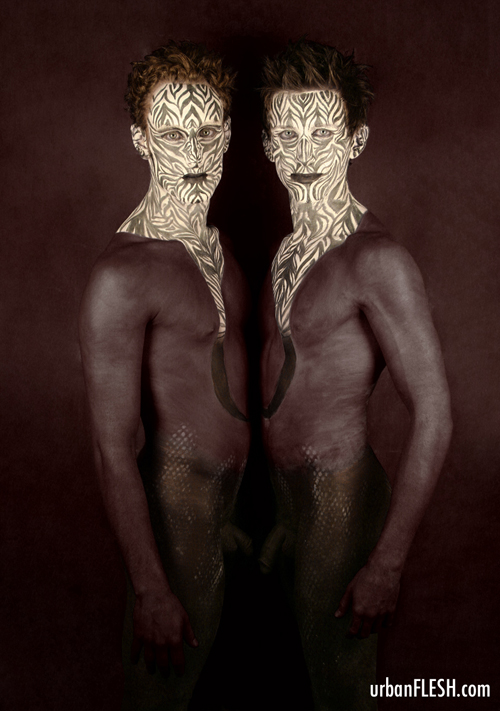Anthony Larrisey: Body Art
Anthony Larrisey is an internationally-acclaimed body painter whose work spans the worlds of Fashion, Film, Photography, Television, Events and Private commissions.
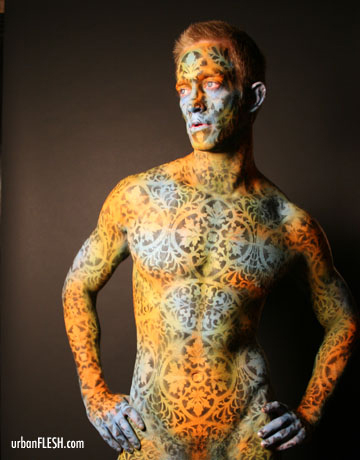 How would you describe your art to someone who’s never seen it before?
How would you describe your art to someone who’s never seen it before?
To me it’s an art form, but also an experience, something that is transformative: starting with a blank canvas, in this case the skin, completely reimagining what that is using the body, using the texture of the skin, the personality of the individual model that I’m painting to create that form of art. So the way that I describe it is this temporary experience, a living, morphing piece of art.
Whereas other artists will use other mediums and create a painting or an installation, and it lasts, and people can see it and it can travel, in my medium the art itself is only in that moment.
Many people who have experienced it and seen how much work goes into creating one execution– only to see it extinguished within a moment– can’t understand how you can put so much time and dedication into a painting and then have it be gone moments later, after a photo shoot or scene or whatever.
I think it makes it more special, because it is something that exists at just that moment. So having an opportunity to experience it live, it’s something more than others would be able to have because they’re not physically present….and it’s a fleeting moment, it can never be recaptured or recreated to the same degree.
For others that might be the frustrating thing—some of the designs I do take up to 10 or 12 hours to create, but the final product lasts only as long as the model keeps the paint on. But for me I love that, that it’s a really condensed moment of experience. Have you been painted?
No, I haven’t….
See, we should have done that for this interview!
I’m down—can you paint a six-pack on me?
(laughs) That’s the magic of make-up!
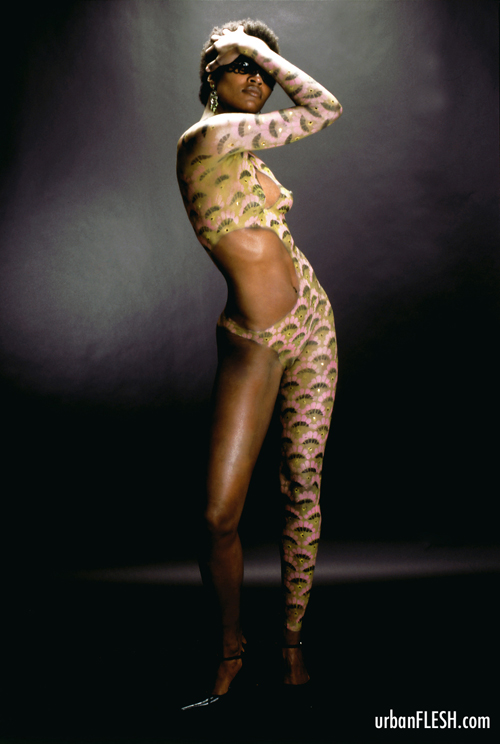 What parts of your overall artistic process do you find most gratifying?
What parts of your overall artistic process do you find most gratifying?
For me the transformation is the really cool thing, as opposed to the end result. I mean, I love to look at the final result, and see from concept to execution, that’s the icing on the cake, but the way that I work is that I have a vision for what I want, or if it’s commissioned or if there’s a client involved, what they’re requesting, and then sort of backing out of that to figure out how to make it all happen.
There are different techniques I use, and different mediums and different applications for the makeup. I love figuring that out, breaking things down into different layers, seeing how different colors and types of product blend or react to each other. It’s almost a scientific approach to things, you start with the bare flesh, and then use different products and techniques to create depth and texture and shadow.
There’s actually a point where you see things really starting to happen—you start to see the light in the dark, you start to see perspective come in.
Most painters start with a flat, 2-dimensional surface, and add depth and perspective for the appearance of 3D…me, I’m starting with a 3D canvas, and in some cases I’m thinking about how to create the opposite effect.
People tend to think these photos are photoshopped, which kills me because we spent 12 hours in the studio painting everything by hand! It’s an illusion, it’s an effect of painting crooked lines on a 3-dimensional body so that it photographs straight.
 There’s one effect that I do where I paint a large-scale canvas and then paint the model to blend in with the background. It’s interesting because a straight line painted on a flat canvas is just that, a perfectly straight line….but a straight line on a person has to be drawn essentially crooked, so that when you’re photographing it, with all the peaks and valleys of the body, it photographs straight. So (pointing at photo) while this line here looks like a perfectly straight line, it’s actually curved to match the curves of the model’s chest.
There’s one effect that I do where I paint a large-scale canvas and then paint the model to blend in with the background. It’s interesting because a straight line painted on a flat canvas is just that, a perfectly straight line….but a straight line on a person has to be drawn essentially crooked, so that when you’re photographing it, with all the peaks and valleys of the body, it photographs straight. So (pointing at photo) while this line here looks like a perfectly straight line, it’s actually curved to match the curves of the model’s chest.
How do you manage to pull that off?
It’s a very involved process. I start with the canvas, and I line the model up, and essentially a good model who has complete control over their body & poses will figure out what the pose is going to be, and in this case he stood there while I made the marks with tape & eye pencil of where the background image will hit his body.
The model then steps away and I mark exactly where he was standing, and I take photographs before the paint goes on…..kind of like when you’re making a movie, someone will take photos to make sure that there’s consistency in the shots on the set from one day to the next, it’s the same idea here. We take photographs during the whole course of each of the colors, so that every time he goes back into position everything lines up perfectly.
People tend to think these photos are photoshopped, which kills me because we spent 12 hours in the studio painting everything by hand! It’s an illusion, it’s an effect of painting crooked lines on a 3-dimensional body so that it photographs straight.
The crazy thing is that out of a full day’s photoshoot, you walk away with maybe 2 photos that work, just because it’s so physically challenging for the model to, without being able to see themselves, get the lines to match up exactly right.
 I like to do a lot of stuff with texture and pattern. This one right here, I was in a “stained-glass window” phase….a lot of blending of blues, and greens, and yellows. Creating an effect, and then going over that layer, and another layer, and another layer, until we create a pattern.
I like to do a lot of stuff with texture and pattern. This one right here, I was in a “stained-glass window” phase….a lot of blending of blues, and greens, and yellows. Creating an effect, and then going over that layer, and another layer, and another layer, until we create a pattern.
Honestly, I’m in awe that you’re even able to pull this off, it just seems like it would be so meticulous….
(laughs) But I am, I’m so meticulous! And I looove detail! I love getting in there and doing this super-complex stuff…although of course when I look at these pics I see all sorts of things that I would’ve done differently now. Everything I’ve done has been completely self-taught, it’s been by trial & error and experimenting and having very patient models to work through the process with.
How do you go from initial conception & design to recruiting models?
For my personal work I tend to go through phases, you’ll see some images in my portfolio that are super-complex with pattern, that’s one phase I was in, then others that feel very old world, almost gothic, that was another phase. Then you’ll see lots of painted clothing, and female models always love this because there is that illusion and it’s popular with them, I was doing a lot of those for awhile, which was pretty cool.
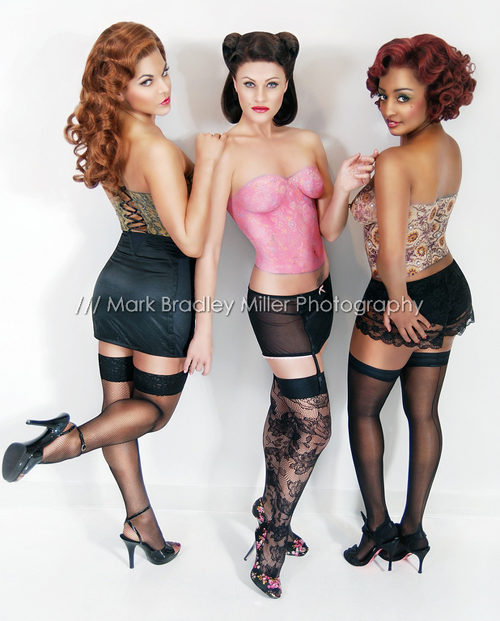 Personally, I just have different areas that I like to explore, for awhile I was doing a lot of tattoo work. So if something strikes me, I’m inspired by something I see in a magazine or something, the ideas just start racing and I just translate that into body art.
Personally, I just have different areas that I like to explore, for awhile I was doing a lot of tattoo work. So if something strikes me, I’m inspired by something I see in a magazine or something, the ideas just start racing and I just translate that into body art.
As far as the models go, with my personal work it’s often friends of mine….
You have a lot of buff friends!
(laughs) I have a lot of buff friends! Who enjoy the process, so everyone walks away happy, it works out well. I’m also involved in a couple different industry professions, I give workshops at the International Beauty Show, and The Makeup Show, talking about technique but also finding inspiration and the overall approach to the medium. So through that and at this point having done this for a few years now, and with my work that’s been published, I get approached often so…it’s cool, I get to work with lots of different types of people.
…and they’re not always these agency models with perfect-sized bodies. I did an exhibition with a photographer friend of mine, we used “real people,” if you will, different shapes and sizes and ethnicities, it was really about celebrating their bodies, them being comfortable in their own skin. . .
Do you ever find yourself altering your design to better integrate the model’s physical form or personality? Or do you tend to stick to a blueprint and find a model that corresponds to what you’re envisioning?
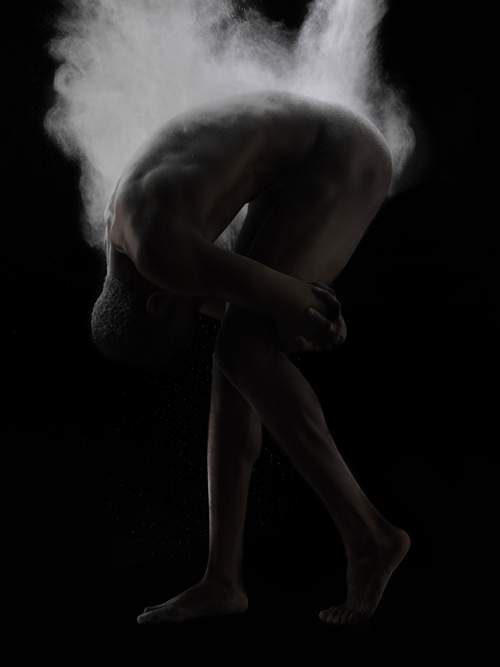 When I’m casting, I love to work with dancers, especially if it’s for a photo shoot, because they are just so connected to their expressive physical forms that regardless of what I paint on them, they can take the design to the next level, more so than your typical model, who often uses clothing or hairstyle to get some sort of a message across.
When I’m casting, I love to work with dancers, especially if it’s for a photo shoot, because they are just so connected to their expressive physical forms that regardless of what I paint on them, they can take the design to the next level, more so than your typical model, who often uses clothing or hairstyle to get some sort of a message across.
That being said, for most magazine shoots I show up on set and the model has already been cast. In those cases it’s a little bit different, and often times you have to make adjustments for the body type, you do have to alter the design. That’s where having sort of a fine arts background comes in handy, because I can make those adjustments.
Also, as you become more involved over the years you actually understand the way the body moves and interacts with product on the skin, so all that kind of plays into the planning and the painting as well.
But whenever there’s an opportunity I love to meet with the model first.
It strikes me as such an incredibly intimate process, one that seems like it would require a lot of trust from both parties. Can you talk a bit about that dynamic?
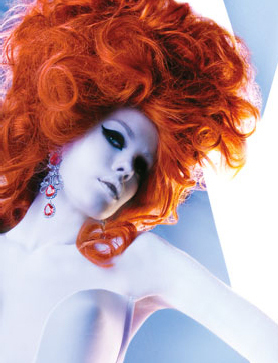 Situations can vary greatly—for personal projects it will often be me, the model, and an assistant to help me photograph my work. In other, more commercial shoots it might be a roomful of 10-15 people.
Situations can vary greatly—for personal projects it will often be me, the model, and an assistant to help me photograph my work. In other, more commercial shoots it might be a roomful of 10-15 people.
Individuals react differently: most models who work and do fashion shows, it’s not an issue at all, but for a model not used to getting undressed and changed in front of lots of people on a regular basis, it’s interesting to see their reaction for the first time, because they do become much more aware of being nude.
Understanding and anticipating that, I try to put people at ease and make them feel comfortable in a situation. Any good makeup artist will talk to the model, tell them what they have planned, manage them through the process, just out of a professional courtesy so they know what’s being done. It’s just a matter of quickly being able to establish the relationship, getting them to feel comfortable, and managing their expectations—what’s going to happen now, this is going to feel this way, now we’re going to put this product on, it’s going to feel cool to the touch, etc.
 Interestingly as the process goes on and as we do the prep work and the first layer of paint goes on, you see them get more & more relaxed, and what the models tell me is that they either become more acclimated and comfortable being in that situation, or that somehow psychologically having all those layers of color & design & texture gives them some sense of security.
Interestingly as the process goes on and as we do the prep work and the first layer of paint goes on, you see them get more & more relaxed, and what the models tell me is that they either become more acclimated and comfortable being in that situation, or that somehow psychologically having all those layers of color & design & texture gives them some sense of security.
How do they react to their own transformation?
They love it! For them to see the transformation seems to be very rewarding and interesting…and they’re curious about the process.
I’ve had models leave shoots fully painted, we typically will remove all makeup at the end of a shoot, but some want to go home and show their significant other. I had one guy who had a full body tattoo design, he left and went to the gym, he always wanted a full body tattoo and he had one, so off he went!
Once the paint is sealed up, our job is done…from there the model has to bring the energy, they have to use expression…
What kind of music do you tend to play while you’re working?
I usually ask the model if they have anything that they’d like to hear, the iPod is full of different genres, but typically we’ll have something high-energy in the beginning, just to get things loose & get things rolling, and somehow it always morphs into a neo-soul vibe. Models have actually fallen asleep before. After we get through the introductions and the comfort level of being exposed, it is relaxing, it’s like getting a massage sometimes, there’s touch points, and the brush going over & the neo-soul kicking in it’s a really relaxed, comfortable environment. And the trust is there at that point, so they just go somewhere, you know?
It’s cool that you’re so conscientious of making the model comfortable and talking them through it. It’s interesting how you get your creative catharsis but at the same time at the heart of it it’s a collaboration.
Absolutely. It’s based on their energy, and their personality does come through in the final execution. Once the paint is sealed up, our job is done…from there the model has to bring the energy, they have to use expression…and again that’s why I love working with dancers because they get it, and they can express so much through their bodies and through facial expression. You have to have someone who’s good, they’ve got to be able to move their body.
And interestingly, the models work through different poses to change the design, and again that’s the cool thing about working with this moving, 3-dimensional canvas, it continually morphs. They change the stance, they change the positioning, the design changes as well. So that’s something even during my preparation that I have to think about, that as a model changes and breathes, looks in a different direction, the design changes.
The story that we needed to tell, which was race-driven, was completely shifted by what was happening with me changing this black man’s skin to white…
 Sometimes things happen unexpectedly…after Katrina I was working with some other makeup artists who volunteered their time to Vidal Sassoon to this whole campaign of celebrity hair stylists who use their hands in their work.
Sometimes things happen unexpectedly…after Katrina I was working with some other makeup artists who volunteered their time to Vidal Sassoon to this whole campaign of celebrity hair stylists who use their hands in their work.
One of the guys who I was working with, his name’s Ted Gibson— celebrity hairstylist, African-American man, he was representing a black family from New Orleans, the story was based on race , and ultimately the messaging was going to be based on being recognized. If you recall what was going on, it was marked by the lack of response on the part of the government to these people who were in need.
The design was set based on what the art director had requested, so I was working. I had backed out of the final result to my process, to the steps that I needed to achieve. The first thing that I needed to do was prep his hands, which was to apply a solid coat base of white makeup, and as I was doing that, the art director, who hadn’t necessarily worked a lot with body paint, asked what I was doing.
I responded saying, “Oh, this is the first step, this is how I prime the skin so that we can build to get that final effect,” and she said “Stop, something has happened here, this is incredible.”
Ultimately what happened was, the story that we needed to tell, which was race-driven, was completely shifted by what was happening with me changing this black man’s skin to white, and the final image became him with his now painted-white hands forth-stretched, and on his hands was, “Will you see me now? Now that I have white skin, now will you see me, now will you pay attention?” And he actually cried during his photo shoot….when this happened it literally silenced a room of about 50 people. He cried, he had his hands out in this powerful moment.
Mind you, this was completely different from what the original design was, but it happened as the process evolved and we shifted gears. It was….amazing. So, you can’t plan for things like that.
It was a great opportunity to work with a lot of different photographers, art directors, to be able to surround myself with people who were so passionate about what they do.
What kind of training or background have you had, and how did that parlay into the body art?
It was never anything formal, I just come from a family of painters and writers, so we grew up reading and being immersed in that environment. From a young age I always painted, sculpted, and worked in different mediums.
The body paint was something I was attracted to because not a lot of people do it, it’s not done on a mass level, it just felt more interesting to me, more special. I’d seen it done a couple times, at events and in magazines—for example with Joanne Gair, who did the Vanity Fair cover with Demi Moore, and the Sports Illustrated swimsuit issue which everyone knows.
I also had a lot of friends who work at MAC Cosmetics, so just hearing about different programs they were involved in, fundraisers and that sort of thing…that was all intriguing to me.
As an artist I’d worked with watercolors and oil paints and pastels, and wanted to experiment, wanted to diversify, wanted to work with a new medium, so I said, “Why not? This body paint thing could be kind of cool.” I went to a makeup pro shop, bought some products, recruited a couple of friends of mine who I knew would be willing, and just started to experiment and figure out how the paints worked, and how to create different effects.
 From there I just started to put my book together, and things just took off! The interesting thing is that there are not a lot of artists that do body paint, so when opportunities came up with different magazines, photo shoots, photographers, for the few of us that work in the industry that have some level of success, the phone would ring—which is great! And once I got really into it I was able to do more complicated designs and more complicated techniques, I just went off, I produced a whole deck of cards, started to put together some images for some gallery shows.
From there I just started to put my book together, and things just took off! The interesting thing is that there are not a lot of artists that do body paint, so when opportunities came up with different magazines, photo shoots, photographers, for the few of us that work in the industry that have some level of success, the phone would ring—which is great! And once I got really into it I was able to do more complicated designs and more complicated techniques, I just went off, I produced a whole deck of cards, started to put together some images for some gallery shows.
At that point I was contacted by David Leddick, who is an art historian and editor (he does books for Rizzoli), so I was published, and everything sort of opened up.
So, it was a great opportunity to work with a lot of different photographers, art directors, to be able to surround myself with people who were so passionate about what they do, and collaborate with some really amazing, amazing people.
So you had no formal design training whatsoever?
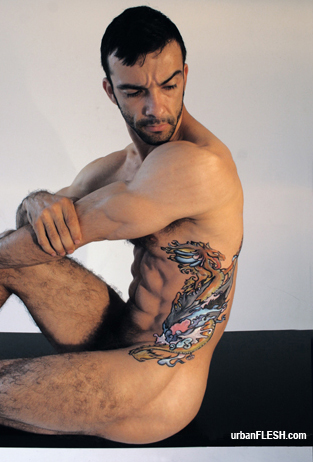 No, I think it’s just growing up in the household that I did, and always having the opportunity to experiment and to paint and to work in different mediums, I just love it, it’s something that comes from within, and I think when you’ve got that passion, that desire, you experiment and you think about how to create….it’s a lot of trial and error.
No, I think it’s just growing up in the household that I did, and always having the opportunity to experiment and to paint and to work in different mediums, I just love it, it’s something that comes from within, and I think when you’ve got that passion, that desire, you experiment and you think about how to create….it’s a lot of trial and error.
I always practice on myself, especially for any commercial shoot. I have some models that I’ll bring in just to do tests before going on set with about 15 people standing around expecting you to do everything perfectly.
I love the opportunities to do full body, you know head to toe, 360 degree installation. But sometimes I’ll be brought in to do something like a tattoo, which looks like it’s been on a person’s arm for 20 years. With ZINK, when they launched ZINK Canada, I was brought in just to paint the Canadian flag on a model’s lips.
I saw that!
 So an entire gig, just painting a girl’s lips with the Canadian flag…so for that I practiced. And for that there’s the pressure of going into a shoot for a client where you’ve got to make things right quickly, everyone’s being paid, the studio’s being rented, there’s a timetable, so you have to be able to go in and deliver and have things look the way they’re expected to look.
So an entire gig, just painting a girl’s lips with the Canadian flag…so for that I practiced. And for that there’s the pressure of going into a shoot for a client where you’ve got to make things right quickly, everyone’s being paid, the studio’s being rented, there’s a timetable, so you have to be able to go in and deliver and have things look the way they’re expected to look.
You mention that you prepare a lot before a gig, do you have any certain techniques that you use going into a shoot, so that you can allow yourself to relax and be this creative conduit?
Well, the fact is, it’s really preparation—I go in with every detail sketched out, with stencils made, with all the product (gestures to rows of boxes on shelves). I’ve got airbrush machines, and paintbrushes and sponges, so I have what I need in order to do what’s expected of me, and every detail is planned out, which is interesting because, as much freedom as you want as an artist, for this you really have to be focused and buttoned up and prepared, because you’re working on a very specific design.
The worst thing to do is show up on set without a fully-baked idea or without all the tools that you need. And also, and this comes with experience . . . having an idea how long something’s going to take, so that you can assemble your team and manage everyone’s expectations.
And that all comes from being confident in your artistic ability, to be able to make changes, to adapt, to make changes on set that weren’t talked about previously….I think it’s having the mindset that that could happen, and having the tools to do it, and the confidence to execute what’s being requested, and at the same time being able to manage those on set with you.
Otherwise, I think it’s just my disposition to handle pressure and to stay cool and know that we can process anything that comes our way.
I’m a big believer in putting good energy out there, if we can do something with what we do or a talent or skill, and have something good come from it, it makes it all worth it.
Is there a particular piece that you’re especially proud of?
 Wow….it’s hard….you know, each one really is so personal because it is one of a kind, it lasts only moments, so there really is an attachment to every image in my book.
Wow….it’s hard….you know, each one really is so personal because it is one of a kind, it lasts only moments, so there really is an attachment to every image in my book.
Certainly the work with Rizzoli, on a professional level, I’m very proud of that. I’m so grateful for the opportunity to be published and be a part of a project with David Leddick, who I was aware of as a photographer and had done so much for the art world, to be included in his book.
On a personal level, doing the exhibition with Edwin Ho and having all the proceeds go to breast cancer is meaningful because my mom is a breast cancer survivor, so being able to do something with this medium to help others, to have something meaningful, is a beautiful thing.
I was going to ask you about the philanthropy aspect…
Yeah, I’ve done an exhibition with Gilda’s Club, and every year MAC Cosmetics is gracious enough to invite me to come in as a guest artist for Broadway Bares, it’s a one-night only benefit burlesque show that brings out all these celebrities, and everyone strips and there are 8-10 different numbers, all very fun, it’s just a blast.
There’s ticket sales, MAC Cosmetics is one of the corporate sponsors, and this past year we raised over a million bucks, so yeah…amazing that for one night’s effort we were able to raise so much money for Broadway Cares/Equity Fights AIDS.
I’m a big believer in putting good energy out there, if we can do something with what we do or a talent or skill, and have something good come from it, it makes it all worth it. And it’s a blast, we always have lots of body paint, there’s lots of glitter and skimpy costumes, and the talent of course is just…unreal. It’s fun, it’s a little racy, and we’re raising a lot of money for people who are in need, and it feels good at the end of the day. I’m always happy and privileged to work with them.
Are there any upcoming projects that you’re excited about?
I’m developing this series of the Seven Deadly Sins, I’ve got the sketches done, I’ve got this whole plan to create the Sins personified, which is going to be very Old World with script incorporated into the design as well, taking some influence from old leatherbound books, handwritten letters…I’ve looked into the meanings of each of the Seven Deadly Sins and some of the different cultures have different thoughts behind it, there’s animals that represent the sins, there’s colors, in these cases I spend a few weeks looking into the meaning + stories that we’ve always learned about or talked about in school, and then turning that into some kind of installation with body paint execution.
I’ve got the models lined up, and I’ve been doing research for about a year, off and on, just so that I can truly understand the meaning, the significance, some of the messaging that’s laid into the tales and how they came to be, and figuring out how to incorporate that into the design as well.
If you’re not excited about what you’re doing and can’t find challenges and thrive when you develop new ways to approach those situations and think about how to expand, then you’re doing something wrong!
Is there a certain direction that you’d like to go in the future, as far as artistic career in general, or are you just simply open to the possibilities?
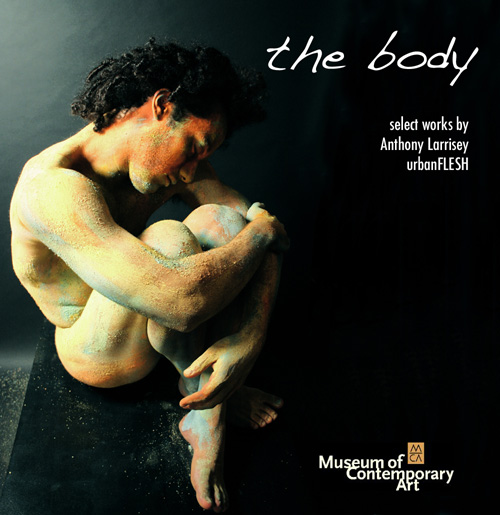 I’m always open to the possibilities, for me though it’s definitely more about doing these special projects and being included in more gallery shows. I was part of this multimedia show with the Museum of Contemporary Art in Chicago, it was about the body, I participated along with other individuals who used the body either in their art form or as a medium, which was really cool, to be part of this really eclectic group of people who were all working with the body in different capacities.
I’m always open to the possibilities, for me though it’s definitely more about doing these special projects and being included in more gallery shows. I was part of this multimedia show with the Museum of Contemporary Art in Chicago, it was about the body, I participated along with other individuals who used the body either in their art form or as a medium, which was really cool, to be part of this really eclectic group of people who were all working with the body in different capacities.
Some artists thrust themselves into their creative pursuits, and their every waking moment is informed by this. Others maintain a separation between their muse and their careers for fear that turning their passion into a job will rob it of the fulfillment it brings.
What are your thoughts on this? I know that separate from bodypainting you have your career in event marketing.
You know, I never set out to do body paint as a way of making a living, it’s just something that happened naturally. The artwork I have always done, I have done for pleasure. I grew up in that sort of household, where we were always writing and painting, so my diversion into body art was just a new medium for me, it was just exploration, being able to try something different.
 It just so happened that I loved it, and it became my passion….but I never set out do it as a career, I don’t even consider myself a makeup artist, although I work with many incredible makeup artists. I consider myself more as a painter who happens to use makeup as a medium.
It just so happened that I loved it, and it became my passion….but I never set out do it as a career, I don’t even consider myself a makeup artist, although I work with many incredible makeup artists. I consider myself more as a painter who happens to use makeup as a medium.
So the fact that I’ve been hired for jobs and recruited for photo shoots and books and all that, it’s been unexpected, and I’m grateful for it, but it really has been just the icing on the cake. It’s not necessarily what I would consider my career, it’s always been my passion. The fact that I’ve been able to get payment on some of it has been coincidental.
It’s interesting to think about though, because even my event work is me doing something that I love. I always feel sad for people who are not loving what they do every day, and that sounds cliché but if you’re not excited about what you’re doing and can’t find challenges and thrive when you develop new ways to approach those situations and think about how to expand, then you’re doing something wrong!
It happens that the event work is the track that I’ve decided to make a career out of. It’s still the same approach, a means of working with some incredibly talented people, doing things that I enjoy, having something that I can look at as the result of a lot of hard work, and be proud of that and be able to enjoy that moment.
I think that what people so often do is it break things down financially, and that dictates how they think about their career, but for me it just comes back to that experience, of having that moment and be able to enjoy and thrive in that.
Do you have any advice for aspiring artists?
I think if you’ve got the feeling that you need to explore, then you’ve got to do it! And just like I did, recruit friends who you think would be willing, get some products and start experimenting! There’s so many great mentor programs and industry shows where you can talk to people working in a business and people who can inspire you and give information and advice. The opportunities are there, the availabilities are there, it’s just a matter of when you make the decision to do something, you do it.
The first step is actually making up your mind that you’re going to act on something, and then everything else falls into place after that. That’s the crucial turning point, making the decision to do something, to take action.
You can keep up with Anthony and his body art at urbanflesh.com
Anthony also heads Event LAB, a full-service event marketing agency







